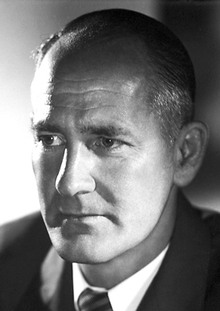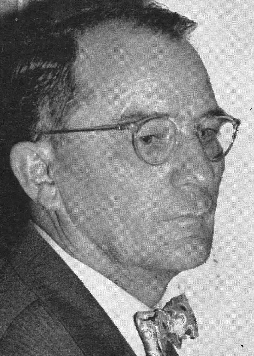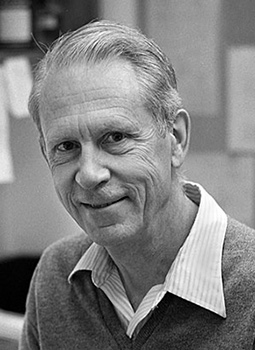Related Research Articles

Theodosius Grigorievich Dobzhansky was a prominent geneticist and evolutionary biologist. He was a central figure in the field of evolutionary biology for his work in shaping the modern synthesis. Born in the Russian Empire, Dobzhansky emigrated to the United States in 1927, aged 27.

The modern synthesis was the early 20th-century synthesis of Charles Darwin's theory of evolution and Gregor Mendel's ideas on heredity into a joint mathematical framework. Julian Huxley coined the term in his 1942 book, Evolution: The Modern Synthesis.

Leroy "Lee" Edward Hood is an American biologist who has served on the faculties at the California Institute of Technology (Caltech) and the University of Washington. Hood has developed ground-breaking scientific instruments which made possible major advances in the biological sciences and the medical sciences. These include the first gas phase protein sequencer (1982), for determining the sequence of amino acids in a given protein; a DNA synthesizer (1983), to synthesize short sections of DNA; a peptide synthesizer (1984), to combine amino acids into longer peptides and short proteins; the first automated DNA sequencer (1986), to identify the order of nucleotides in DNA; ink-jet oligonucleotide technology for synthesizing DNA and nanostring technology for analyzing single molecules of DNA and RNA.

George Wells Beadle was an American geneticist. In 1958 he shared one-half of the Nobel Prize in Physiology or Medicine with Edward Tatum for their discovery of the role of genes in regulating biochemical events within cells. He also served as the 7th President of the University of Chicago.

Neurospora crassa is a type of red bread mold of the phylum Ascomycota. The genus name, meaning 'nerve spore' in Greek, refers to the characteristic striations on the spores. The first published account of this fungus was from an infestation of French bakeries in 1843.

The history of genetics dates from the classical era with contributions by Pythagoras, Hippocrates, Aristotle, Epicurus, and others. Modern genetics began with the work of the Augustinian friar Gregor Johann Mendel. His work on pea plants, published in 1866, provided the initial evidence that, on its rediscovery in 1900, helped to establish the theory of Mendelian inheritance.

Roger John Williams, was an American biochemist. He is known for is work on vitamins and human nutrition. He had leading roles in the discovery of folic acid, pantothenic acid, vitamin B6, lipoic acid, and avidin. He was elected to the National Academy of Sciences in 1946, and served as the president of the American Chemical Society in 1957. In his later career he spent time writing for a popular audience on the importance of nutrition.

Neurospora is a genus of Ascomycete fungi. The genus name, meaning "nerve spore" refers to the characteristic striations on the spores that resemble axons.
John Norman Abelson is an American molecular biologist with expertise in biophysics, biochemistry, and genetics. He was a professor at the California Institute of Technology (Caltech).

David Dexter Perkins was an American geneticist, a member of the faculty of the Department of Biology at Stanford University for more than 58 years, from 1948 until his death in 2007. He received his PhD in Zoology in 1949 from Columbia University. A member of the National Academy of Sciences, he served as president of the Genetics Society of America in 1977. In a scientific career that spanned more than six decades, Perkins collaborated on more than 300 papers. His associates included many graduate students and postdoctoral fellows who went on to scientific careers throughout the world.
Robert Lee Metzenberg was an American geneticist known for his work on genetic regulation and metabolism with Neurospora crassa.
The one gene–one enzyme hypothesis is the idea that genes act through the production of enzymes, with each gene responsible for producing a single enzyme that in turn affects a single step in a metabolic pathway. The concept was proposed by George Beadle and Edward Tatum in an influential 1941 paper on genetic mutations in the mold Neurospora crassa, and subsequently was dubbed the "one gene–one enzyme hypothesis" by their collaborator Norman Horowitz. In 2004, Horowitz reminisced that "these experiments founded the science of what Beadle and Tatum called 'biochemical genetics.' In actuality they proved to be the opening gun in what became molecular genetics and all the developments that have followed from that." The development of the one gene–one enzyme hypothesis is often considered the first significant result in what came to be called molecular biology. Although it has been extremely influential, the hypothesis was recognized soon after its proposal to be an oversimplification. Even the subsequent reformulation of the "one gene–one polypeptide" hypothesis is now considered too simple to describe the relationship between genes and proteins.

William Henry Press is an astrophysicist, theoretical physicist, computer scientist, and computational biologist. He is a member of the U.S. National Academy of Sciences, the American Academy of Arts and Sciences, and the Council on Foreign Relations. Other honors include the 1981 Helen B. Warner Prize for Astronomy. Press has been a member of the JASON defense advisory group since 1977 and is a past chair.
Dorothea Bennett was a geneticist, known for the genetics of early mammalian development and for research into mammalian sperm surface structures and their role in fertilization and spermatogenesis. She was "one of the major figures in mouse developmental genetics".
Esmond Emerson Snell (September 22, 1914 – December 9, 2003) was an American biochemist who spent his career researching vitamins and nutritional requirements of bacteria and yeast. He is well known for his study of lactic acid-producing bacteria, developing microbiological assays for a number of key nutrients; the discovery of more than half of known vitamins has been attributed to the use of this work. He discovered several B vitamins, including folic acid, and characterized the biochemistry of vitamin B6 (also known as pyrixodal).
Molly S. Bray is an American geneticist, currently the Susan T. Jastrow Human Ecology Chair for Excellence in Nutritional Sciences at University of Texas at Austin. Bray is a nationally recognized expert and a featured speaker on the genetics of obesity, energy balance, and exercise response. She is a Professor and chair in the Department of Nutritional Sciences at the University of Texas at Austin, with a master's degree in Exercise Physiology from the University of Houston and a PhD in Human and Molecular Genetics from the UT Graduate School of Biomedical Sciences. She also served as the former Director of the Heflin Center for Genomic Science Genomics Core Laboratory at the University of Alabama at Birmingham and the Children's Nutrition Research Center/Baylor College of Medicine Genetics Core Laboratory. Bray's research focuses on the relationship between energy balance and lifestyle factors such as exercise, nutrition, and circadian patterns of behavior. Her findings related to how the timing and quality of energy intake affect weight gain and metabolic health have been featured on national and international news programs and a myriad of websites and popular news media. Bray also currently leads one of the largest genetic studies of exercise adherence established to date, the Training Interventions and Genetics of Exercise Response (TIGER) study, with a total cohort of more than 3,700 individuals. Bray's research has included investigations of aerobic fitness and resting and exercise energy expenditure in children and adolescents, circadian studies of feeding and metabolic response, and clinical studies of morbidly obese adolescents undergoing bariatric surgery. Bray has published extensively in a wide range of peer-reviewed journals and her work has been featured in national and international scientific meetings.
Herschel Kenworthy Mitchell was an American professor of biochemistry who spent most of his career on the faculty at the California Institute of Technology. He was one of many researchers interested in vitamin B6 in the early 1940s and is credited as one of the discoverers of folic acid. He later focused his research on Drosophila, in particular the genetics and biochemistry of the heat shock response.
Jerome Edwin Hirsch was an American psychologist known for his pioneering work in behavior genetics, and for his advocacy for social justice. He has been described as "the pioneer who brought quantitative genetic analysis to the study of behavior."
Elliot Max Tucker-Drob is Professor of Psychology at the University of Texas at Austin, where he is also a Professor of Psychiatry, a faculty research associate at the Population Research Center, a faculty research associate at the Center for Aging and Population Studies, and director of the Lifespan Development Lab. He is the co-founder and co-director of the Texas Twin Project. He is known for his research in the fields of developmental psychology, cognitive aging, behavioral genetics, and statistical genetics. This has included research on the effects of education and socioeconomic status on children's cognitive development and academic achievement; cognitive aging and dementia; the genetic architecture of psychiatric disorders; and the development of Genomic Structural Equation Modelling, a statistical framework for the multivariate analysis of genome-wide association study data.
Beverly Marie Guirard was a microbiologist who worked on the biochemistry of microbial growth, especially with respect to vitamin B6. She is also known for her work defining the components of coenzyme A which was a part of the research that led to a Nobel Prize for Fritz Albert Lipmann.
References
- 1 2 3 4 5 6 7 8 9 Sanders, Bob G.; Cassady, William E.; Lagowski, Jeanne M.; Sutton, H. Eldon. "In Memoriam: Robert Philip Wagner". University of Texas Faculty Council Memorial Resolutions. Retrieved 12 January 2017.
- ↑ Wagner, Robert P.; Crow, James F. (1 January 2001). "The Other Fly Room: J. T. Patterson and Texas Genetics". Genetics. 157 (1): 1–5. doi:10.1093/genetics/157.1.1. PMC 1461468 . PMID 11139486.
- ↑ Wagner, Robert P.; Guirard, Beverly M. (1948-08-01). "A Gene-Controlled Reaction in Neurospora Involving the Synthesis of Pantothenic Acid". Proceedings of the National Academy of Sciences. 34 (8): 398–402. Bibcode:1948PNAS...34..398W. doi: 10.1073/pnas.34.8.398 . ISSN 0027-8424. PMC 1079130 . PMID 16588819.
- 1 2 "A Guide to the Robert P. Wagner Papers, 1930-2004". University of Texas at Austin. Retrieved 12 January 2017.
- ↑ Hildebrand, Carl E.; Torney, David C.; Wagner, Robert P. (1994). "Informativeness of Polymorphic DNA Markers". In Cooper, Necia Grant (ed.). The human genome project : deciphering the blueprint of heredity . Mill Valley, Calif.: Univ. Science Books. ISBN 978-0935702293.